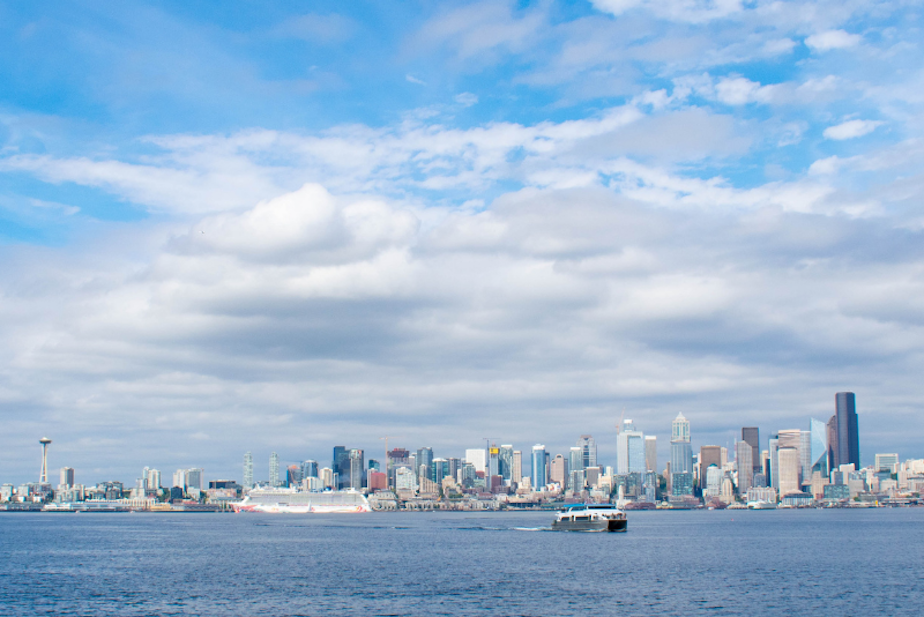The high environmental cost of cheap cruises

Next month, it begins again.
Tourists flooding Pike Place Market, plonking their luggage onto precious light rail seats, crowding downtown bars and restaurants.
Yes, we’re talking about the start of the Alaska cruise season.
This year, an estimated 700,000 people will get on a cruise ship in Seattle, heading to the open seas. And that many people means a lot of environmental impact.
Journalist Andrew Engelson recently reported on the byproducts of cruises for Hakai Magazine. He did so by creating a fictional cruise ship — the Oceanic Topaz.
The article follows its seven-day journey, starting in Seattle before heading to Ketchikan, Juneau, and Skagway in Alaska, as well as a pit stop in in Victoria, British Columbia.
"We wanted to tell sort of an emblematic journey of a ship. And we couldn't prove for certain you know, what happened on a specific ship on a specific journey," Engelson said.
Sponsored
So, he gathered data on what typically happens on a 3,600 passenger ship, the usual size for a cruise.
"These are giant floating hotels, several football fields in length. They're huge," Engelson said.
And every one of those 3,600 people is brushing their teeth, using the bathroom, eating food. In other words, they're producing waste in the forms of trash and sewage.
The ship itself is also powered by diesel fuel.
"On this particular journey, it would put out 2,800 metric tons of CO2 on a seven-day journey, which is equivalent to about 600 cars traveling in the U.S. for a year," Engelson said.
Sponsored
He also mentioned that there are 13 ships sailing between Alaska and Seattle this year. They're projected to go on a combined total of 291 trips between the two states.
Wastewater, both treated sewage and grey water, are also forms of pollution produced by cruise ships.
While these ships are docked in Seattle, they're given the option to turn off their engine, instead plugging into power from the port. But Engelson said so far, not many ships are taking up the option. In 2021, 37% of ships chose to plug in. In 2022, it decreased to 21%.
Engelson said the ships that choose not to plug in are instead idling their engines by the shore, producing atmospheric pollution.
But that may change in the near future.
Sponsored
"We are working towards having all of our cruise ships plug in. It will be a requirement by 2030, if not sooner," said Stephanie Jones Stebbins, managing director of Maritime at the Port of Seattle.
Jones Stebbins also noted that the reason for the decrease in plug ins between 2021 and 2022 is due to an increase in ships.
"In 2021, we were just recovering from the pandemic and it had far fewer ships than usual; we had only about a quarter of our of our regular season that year," she said.
A higher percentage of those ships were equipped for shore power. As business rebounded last year, far more ships came to shore, and fewer of them were equipped for shore power.
Jones Stebbins said the Port is also considering other options for improving the environmental impact of large ships.
Sponsored
This week, the Port is holding a webinar about its “Green Corridor” initiative that explores possible ways to decarbonize all cruise and shipping routes between Washington, British Columbia, and Alaska.
Currently, national, state, and local environmental regulations vary. So, depending on where the cruise is on its journey from Washington to Alaska, it will be following different guidelines.
This project combines the efforts of the different states to consider a fully decarbonized cruise route. Jones Stebbins said that would likely mean looking at alternative, zero-carbon fuel sources, as opposed to diesel.
But Engelson noted that the switch to natural gas is likely a long way off. Any of these changes will be really expensive and require a lot of investment from the cruise industry, which could be difficult, because a lot of these ships run on really small margins, he said.
"One of the selling points of these trips is that they are cheap and convenient and accessible. And that's true," Engelson said. "For someone who wants to take a vacation, it's a really inexpensive, easy way to take a trip. But that cheapness comes at a cost."
Sponsored
Information about the Port of Seattle's Green Corridor update can be found at this link.





